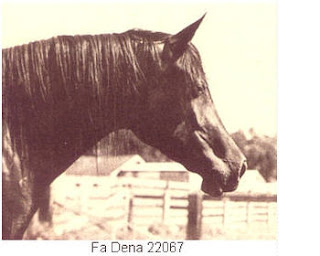 |
| Daaldan (Faddan x Fay Dalla) |
 |
| *Bint Bint Durra with Elizabeth Babson Tieken astride |
So dear reader, maybe I have captured your interest and you are now asking who was this horse named Daaldan and what was his story?
In the early 1940's, an American by the name of Walter Ross had purchased two colts from the Babson Farm:
- El Ahmar (*Aldebar x Fa El Maar)
- Sabdaan (Faddan x Fay Sabbah)
"Daaldan was unfortunately overlooked in his earlier years, but later was acquired by Mrs. George Fox, of Rogers, Arkansas who made good use of him as a sire." - Judith Forbis, Authentic Arabian BloodstockAfter siring 21 foals, Daaldan was purchased by Mrs. George Fox in 1961. Mrs. Fox was an avid Arabian horse breeder, producing 158 horses through 1974. She used a variety of bloodlines, including Crabbet and Spanish horses in her program. Daaldan sired an additional 41 horses under Mrs. Fox's ownership, including 2 fillies out of Fa Dena, a Fa-Serr daughter: Fa Dena Mia in 1970 and Daal Dena in 1971. Unfortunately, neither mare bred forward in the program. Mrs. Fox also bred Fa Dena to *Ansata Ibn Halima, to produce the full sisters: Bint Fa Dena in 1966 and Il Bint Khedena in 1968, both of whom were sold to Robert Cowling. Bint Fa Dena was bred to Daaldan to produce Bint Daaldan in 1970 and the colts: Daalden in 1971 and Amir Daaldan in 1972. Bint Daaldan was sold to Albert Guilbault and became a significant cornerstone of the Abitibi breeding program. Bred to newer Egyptian horses, she produced valuable mares like Abitibi Zamana and her daughter, Abitibi Madeena, from which, horses like Safeen have emerged.
Fa Dena was also purchased by Robert Cowling and eventually, was sold to Jarrell McCracken, who bred her to a variety of straight Babson and new Egyptian stallions, however, Robert Cowling kept her daughter and chose to breed Bint Fa Dena once more to Daaldan, producing the black beauty, Fa Daalim in 1973, an exceptional black stallion and foundation sire for Marilyn Lang of Fantasia Arabians, in Sealy, Texas. Like her dam, Bint Fa Dena would find her way to Jarrell McCracken, who bred the mare exclusively to *Ibn Moniet el Nefous, producing a lovely mare named Monadena, who, when bred to *Ansata Ibn Halima, produced the mare Halima's Legacy, a significant broodmare for Sherry Moseley, from which SES Bint Fabo and her wonderful daughter, SES Nadira descend.
Mrs. Fox had also purchased another straight Babson Egyptian mare, Fay El Aba, a Fay-el-Dine sired daughter out of Faaba, a *Bint Bint Sabbah daughter by *Fadl. When bred to Daaldan, she produced the stallion, Fay El Dan in 1964 and the mare, Daal Aba in 1964, who became a very significant mare for Walter Schimanski of Masada Arabians, producing so many wonderful mares who have bred forward in the Egyptian community. How can anyone forget the *Ansata Ibn Halima daughter, Walter's beloved, Masada Fay Halima.
It takes a special horse to excel in any show ring but for a horse that qualifies and competes at the National level, it takes an extra special horse to do this, who mentally and emotionally, can withstand the stress of travel, changing scenery, noise, changes in schedule or routine and the demands of rigorous competition. While Daaldan, as an individual, did not participate in the show arena, he sired sons and daughters who produced horses who excelled in performance; winning National titles in Park, Formal Driving, Native Costume and Sidesaddle. Of all the winners, most notable is Aequus+//, a five time National Park Champion in America, as well as a Reserve Champion in Formal Driving, whose genetic fiber includes Daaldan as a maternal great grandsire (through his daughter, Dan-Seyn-Daal, the dam of Aequus' sire, Sheikh Ibn Shiko).
Clearly, I can't think of any horse who is more representative of the dire need for preservation breeding than Daaldan. As Judi Forbis' quote from Authentic Arabian Bloodstock implies, there was a period of time where Daaldan was lost from the Arabian breeding community and even, bred to non-Arab mares. Walter Ross, while focused on breeding the best of Babson's Egyptian imports with the best of Babson's Polish horses, will be remembered more for Daaldan, than any of the combined source horses he bred. I don't believe that Walter realized at the time, of the role that Daaldan would play within the closed herd of Babson Egyptian horses. Maybe, he would not have sold him, waiting to see how he developed, possibly even using him at stud. Had it not been for Walter Ross, we would not enjoy the presence of *Bint Bint Durra, in the same way we do today. Preservation, while urgently needed, even in the face of the declining population of horses descending from the three Babson mares in Daaldan's pedigree: *Bint Saada, *Bint Bint Durra and *Bint Serra I is not dire enough of a situation to also warrant missed opportunities utilizing the influence of Daaldan in different ways, with horses from the other branches of the Bint El Bahreyn family. The 1996 grey stallion, EAI Silvereen (Safeen x Shohreh), a strong and consistent sire across a variety of bloodlines, is representative of the end result in crossing Daaldan (Safeen-Abitibi Madeena-Abitibi Maamouna-Abitibi Zamana-Bint Daaldan-Daaldan) with *Bint Maisa el Saghira (Shohreh-Morgana-Dahma Il Ashekwar-*Bint Maisa el Saghira). Can you imagine a more extensive use of Daaldan, for example, what if Daaldan had been crossed with any of the Abla daughters? What brilliant horses would we now be enjoying if this had been the case. For this reason, Daaldan remains so intriguing, for as important as he was to the preservation movement, he was equally important by bridging the breeding programs of old Egypt and new Egypt, combining bloodlines, that were only separated by time and place.

No comments:
Post a Comment